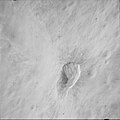 Apollo 15 image Apollo 15 image | |
| Coordinates | 18°22′S 84°16′E / 18.37°S 84.27°E / -18.37; 84.27 |
|---|---|
| Diameter | 78.76 km (48.94 mi) |
| Depth | Unknown |
| Colongitude | 277° at sunrise |
| Eponym | Josiah W. Gibbs |
-
 Oblique closeup of the recent small impact on the north rim of Gibbs, from Apollo 15
Oblique closeup of the recent small impact on the north rim of Gibbs, from Apollo 15
-
 Oblique view from Apollo 17
Oblique view from Apollo 17
-
 Gibbs D from Apollo 15
Gibbs D from Apollo 15
Gibbs is a lunar impact crater that lies near the eastern limb of the Moon. It is situated less than a crater diameter to the northeast of the larger crater Hecataeus. The crater chain Catena Humboldt passes to the south of Gibbs, following a line to the northeast. Due to its proximity to the limb, this crater appears foreshortened when viewed from the Earth, and visibility is subject to libration.
The outer rim of Gibbs is not quite circular, and an outward bulge to the north gives it an onion-like profile. The southeastern wall is slightly straightened and there is a low break in the rim at the southern and northern ends. In other respects, however, the rim is only slightly eroded. The interior floor is nearly level in the southwestern half, with irregular ridges to the northeast. There is a small craterlet to the northwest of the midpoint.
A recent small impact along the northeastern rim, Mirzakhani, has produced a small ray system that forms a skirt of higher albedo material across this part of the rim. Faint traces from these rays cover the interior floor of Gibbs.
The area around the Mirzakhani impact is characterised by an extremely high rockfall density by lunar standards.
The crater was named after Josiah W. Gibbs by the IAU in 1964.
Satellite craters
By convention these features are identified on lunar maps by placing the letter on the side of the crater midpoint that is closest to Gibbs.
| Gibbs | Latitude | Longitude | Diameter |
|---|---|---|---|
| D | 13.1° S | 85.9° E | 13 km |
See also
- 2937 Gibbs, asteroid
References
- Bickel, Valentin Tertius; et al. (2020-06-08). "Impacts drive lunar rockfalls over billions of years". Nature Communications. 11: 1–7. doi:10.1038/s41467-020-16653-3. eISSN 2041-1723. PMC 7280507.
- "Gibbs". Gazetteer of Planetary Nomenclature. IAU/NASA/USGS. Retrieved 1 September 2023.
- Andersson, L. E.; Whitaker, E. A. (1982). NASA Catalogue of Lunar Nomenclature. NASA RP-1097.
- Blue, Jennifer (July 25, 2007). "Gazetteer of Planetary Nomenclature". USGS. Retrieved 2007-08-05.
- Bussey, B.; Spudis, P. (2004). The Clementine Atlas of the Moon. New York: Cambridge University Press. ISBN 978-0-521-81528-4.
- Cocks, Elijah E.; Cocks, Josiah C. (1995). Who's Who on the Moon: A Biographical Dictionary of Lunar Nomenclature. Tudor Publishers. ISBN 978-0-936389-27-1.
- McDowell, Jonathan (July 15, 2007). "Lunar Nomenclature". Jonathan's Space Report. Retrieved 2007-10-24.
- Menzel, D. H.; Minnaert, M.; Levin, B.; Dollfus, A.; Bell, B. (1971). "Report on Lunar Nomenclature by the Working Group of Commission 17 of the IAU". Space Science Reviews. 12 (2): 136–186. Bibcode:1971SSRv...12..136M. doi:10.1007/BF00171763. S2CID 122125855.
- Moore, Patrick (2001). On the Moon. Sterling Publishing Co. ISBN 978-0-304-35469-6.
- Price, Fred W. (1988). The Moon Observer's Handbook. Cambridge University Press. ISBN 978-0-521-33500-3.
- Rükl, Antonín (1990). Atlas of the Moon. Kalmbach Books. ISBN 978-0-913135-17-4.
- Webb, Rev. T. W. (1962). Celestial Objects for Common Telescopes (6th revised ed.). Dover. ISBN 978-0-486-20917-3.
- Whitaker, Ewen A. (1999). Mapping and Naming the Moon. Cambridge University Press. ISBN 978-0-521-62248-6.
- Wlasuk, Peter T. (2000). Observing the Moon. Springer. ISBN 978-1-85233-193-1.